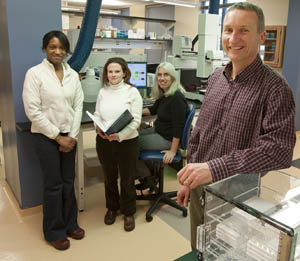Discovery of Inhibitors of MLL Fusion Proteins as Targeted Therapies for Pediatric Acute Leukemia
 Acute lymphocytic leukemia (ALL) strikes 2,500 children per year in the United States alone. For many, ALL is curable, with overall survival approaching 90%. However, 10% of childhood ALL remains difficult to treat, and there is little scope to increase the dosage of chemotherapy, which was developed to treat adult cancer and is highly toxic to children. Thus there is a pressing need to develop novel treatments targeted specifically at pediatric cancer. Many of the most difficult to treat childhood leukemias are triggered by rearrangement of the gene MLL (mixed lineage leukemia). MLL rearrangements are very common in infant leukemia, where they are found in 80% of patients. These infants have an especially grim prognosis: a five-year survival rate of barely 40%. MLL rearrangements disrupt the normal control of gene expression. So-called progenitor cells fail to undergo normal differentiation into specific types of blood cell; instead, they acquire the ability to proliferate unchecked. It is this acquired capacity for 'self-renewal' that is one of the key triggers for acute pediatric leukemia. MLL rearrangements trigger the onset of leukemia through a complex of proteins (transcriptional activators) that have been shown to be essential to the proliferation and survival of leukemic cells. Our goal is to use high-throughput chemical library screening to discover inhibitors of protein binding that disrupt the MLL-linked protein complex in vivo. Optimization of these inhibitors for anti-leukemic potency should lead to the development of targeted molecular therapies for childhood leukemias that harbor MLL rearrangements.
Acute lymphocytic leukemia (ALL) strikes 2,500 children per year in the United States alone. For many, ALL is curable, with overall survival approaching 90%. However, 10% of childhood ALL remains difficult to treat, and there is little scope to increase the dosage of chemotherapy, which was developed to treat adult cancer and is highly toxic to children. Thus there is a pressing need to develop novel treatments targeted specifically at pediatric cancer. Many of the most difficult to treat childhood leukemias are triggered by rearrangement of the gene MLL (mixed lineage leukemia). MLL rearrangements are very common in infant leukemia, where they are found in 80% of patients. These infants have an especially grim prognosis: a five-year survival rate of barely 40%. MLL rearrangements disrupt the normal control of gene expression. So-called progenitor cells fail to undergo normal differentiation into specific types of blood cell; instead, they acquire the ability to proliferate unchecked. It is this acquired capacity for 'self-renewal' that is one of the key triggers for acute pediatric leukemia. MLL rearrangements trigger the onset of leukemia through a complex of proteins (transcriptional activators) that have been shown to be essential to the proliferation and survival of leukemic cells. Our goal is to use high-throughput chemical library screening to discover inhibitors of protein binding that disrupt the MLL-linked protein complex in vivo. Optimization of these inhibitors for anti-leukemic potency should lead to the development of targeted molecular therapies for childhood leukemias that harbor MLL rearrangements.
Project Update (March 2012)
The abnormal proteins resulting from rearrangement of the MLL gene are potent inducers of an aggressive type of childhood leukemia. Since commencing our project less than two years ago, several research groups have accumulated further evidence that MLL-rearranged leukemia is initiated through the action of a complex of proteins that activate expression of cancer-causing genes, a notable example being HOXA9. The HOXA9 gene has an essential normal role to play in early development of blood cell precursors, known as progenitor cells, after which its expression is suppressed to allow differentiation of the progenitors into blood cells. However, in MLL-rearranged leukemia the expression of HOXA9 is maintained at a high level, leading to malignant transformation instead of normal cell differentiation. Control of gene expression is a dynamic process, so the balance between activation and suppression may be altered by targeted intervention, providing an opportunity to develop much-needed therapies for MLL-rearranged leukemia in children.
Our targeted intervention approach is to disrupt the interaction of two proteins essential for HOXA9 expression and malignant transformation: MLL-AF4 and AF9. MLL-AF4 is the most common example of abnormal fusion proteins that result from connection of portions of two normally separate genes during MLL rearrangement. Support from our current ALSF Innovation Award has allowed us to develop an AF4-AF9 binding assay suitable for high-throughput screening (HTS) of chemical libraries, allowing us to test several hundred thousand compounds until we find ones with promising activity. We will shortly begin working with Dr. John Koh at the University of Delaware, who will chemically optimize active compounds to render them suitable for further development. For further compound evaluation, we have set up leukemia cell lines harboring the MLL-AF4 fusion protein, and a mouse leukemia model to select lead compounds for therapeutic development. We plan to study the cellular mechanism of selected compounds with Dr. Charles Hemenway at Loyola University, who originally discovered the importance of the interaction of MLL-AF4 and AF9 to malignant transformation. Progress with assay development and compound screening led to approval from the National Institutes of Health (NIH) to access the resources of the Broad Institute, which in a parallel effort to ours will screen 350,000 compounds and provide medicinal chemistry to optimize the most promising candidates for further development. We are in the process of screening our own chemical libraries, and we have transferred our protocols to the Broad Institute so that they can begin HTS.
With support from ALSF, we have established a collaborative research network, and we are poised to discover chemical compounds that disrupt AF4-AF9 binding and restore normal control of gene expression, and to develop these compounds as therapeutic agents targeted to MLL-rearranged leukemia in infants and young children.

